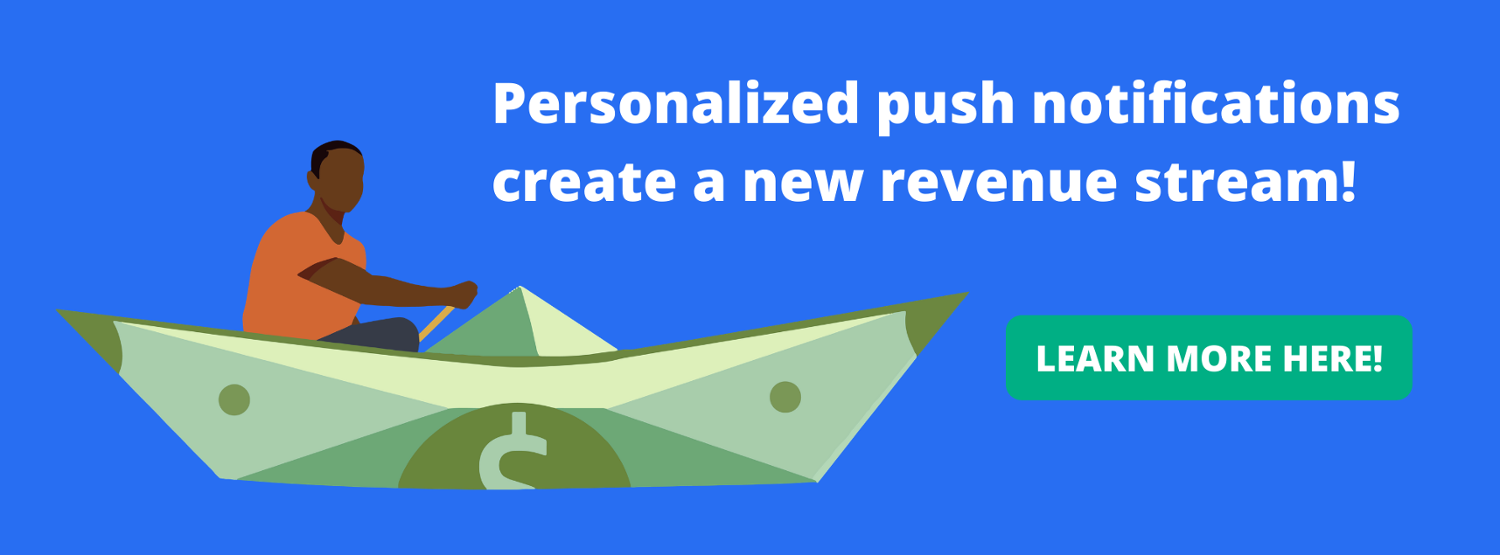Web push notifications are a scalable, engaging solution for reaching your audience. There’s no argument about that.
They pop up on web browsers, reaching consumers directly with breaking news updates, trending content, and special offers in real-time. They’re also opt-in, so publishers know they’re reaching only the most interested consumers — and people know they can trust the messages they’re receiving.
In fact, 72% of Internet users have enabled web push notifications. And it’s no surprise since 64% want to have control over where companies communicate with them.
So, reach? Not an issue. Personalization, on the other hand, is the big variable here. If publishers want to stand out among the noise, how can they personalize web push notifications to drive revenue and user engagement?
Think about it. You probably use personalization to boost your email newsletters and web content. It’s crucial to pair personalization with web push notifications, too. As SmartInsights reported, 72% of consumers will only engage with personalized marketing messages and 80% of frequent shoppers will only buy from brands who offer personalization.
So, in this article, we will be answering the question: “How can publishers customize web push notifications?”
There are 4 key strategies:
TL;DR — check out this video:
1. Customize content to audience interests
With the right first-party data and push notifications platform, publishers can personalize their content to audience interests, needs, and behaviors. They might want to launch different notifications for people who prioritize free shipping vs. those who prioritize product discounts, for instance.
According to SmartInsights, 90% of consumers are willing to share data to receive exclusive discounts on their favorite products, 85% want to know when products are back in stock, and 82% want personalized notifications for new products.
Publishers might also use web push notifications to retarget past customers, send abandoned cart alerts, and update loyal users about trending topics.
Take GoGy Games, for example. The gaming platform partnered with Jeeng to incorporate personalization into push notifications for its 10-12 million monthly website visitors. Jeeng uses machine learning to build smart user profiles and audience segments, automatically delivering targeted notifications to the right users at the right time. As a result, GoGy Games engaged with tens of thousands of users a day, generating both a low bounce rate and long session duration. A simple push message leads to more response from users.
2. Keep your copy specific
It’s important to keep copy as specific as possible, so you can grab the user’s attention quickly and appeal to their unique interests straight on their desktop.
Instead of saying “Enjoy this special offer,” for example, you might say, “Subscribe today for 50% off your first year” because you know this type of offer will appeal to a specific person.
Or instead of saying, “Read these trending stories,” you might lead with the trending headline or content vertical that you already know your audience is interested in. Being direct when sending a web push notification conveys that your company cares about its users and wants to service them.
Also, pay attention to your language settings. Make sure you’re reaching each user with messaging that’s in their language. Seems like a no-brainer, but it’s an easy feature to overlook. To do this, you can set your push notifications to display in the language of the user’s browser, instead of the default OS settings on their device. Talk about custom targeting.
3. Monetize with relevant ads
Personalization isn’t just for organic content. It can also be used to target customers with ad content, increasing user engagement and publisher revenue as a result.
In a recent study we conducted with Mantis Research, we found that 75% of adults are open to seeing ads in push notifications — as long as those ads are relevant to the publisher’s website content.
So, just like you might monetize email newsletters, you can monetize web push notifications with personalization.
A fashion publisher, for example, can monetize push notifications with ads from retailers that match readers’ interests and favorite content. Or a sports publisher can partner with athletic brands or sports teams to expand their audience and deliver sponsored content. In these kinds of push notifications, images matter just as much as text and can be the tipping point for conversions.
4. Choose the right timing
Timing is everything, especially in marketing. You want to reach people when they’re most likely to see your message, engage with it, and click through to continue consuming your content.
So take each demographic’s time zone into account, and consider when audiences are looking to explore new content or sign up for certain offers.
Since GoGy Games is based in Israel, for example, they made sure to schedule notifications for each user’s time zone. As owner Tal Hen said, “Sending a notification at 10 a.m. in Israel does us no good when it gets delivered at 3 a.m. in New York and midnight in Las Vegas.” By working with Jeeng, GoGy Games was able to accurately distribute its push messages with ease and automation.
Bonus tip: Customize web push notification messages for your brand without being pushy
You don’t have to force a hard sell — or risk frustrating users — if you know you’re reaching them at the right time with content that precisely matches their interests. That’s why web push notifications and personalization are so important.
Jeeng can help. Our platform was designed to help publishers launch personalized messaging and monetized content across the most engaging channels — including push notifications. Jeeng gathers your data, analyzes your content, creates user profiles, and sends customized notifications at scale — right to your customers’ web browsers.
Do it all with Google Ad Manager
Jeeng is integrated with GAM so all ads are controlled in one interface, including push notifications. That’s right: with Jeeng, GAM for website, email AND push notifications can all be managed in one central location.
Thanks to this integration, you can drive more traffic back to your website while collecting more first-party data on your subscribers. That’s because AdServe for Push works by pulling ads directly from a publisher’s existing GAM inventory, opening up a new monetization channel for publishers. Meanwhile, you’ve begun expanding to a new engagement channel for brand advertisers to get their content in front of a highly engaged audience, all with almost zero effort. Ad distribution can be manually configured and scheduled, or publishers can let the automated platform do the work on a prescribed response.
Ready to move beyond one-size-fits-all messaging and start launching personalized web push notifications? Contact us today for a demo.





